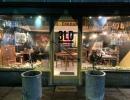Contact Seller
3 Legged Duck Interiors
Tel07789905902Please quote Antiques Atlas.


 Pair of 19thC French Bronze Candlesticks
Pair of 19thC French Bronze Candlesticks
 Pair of French ormolu mounted marble table lamps
Pair of French ormolu mounted marble table lamps
 Pair of Vintage Swedish Brass and Tole Table Lamps
Pair of Vintage Swedish Brass and Tole Table Lamps
 Vintage Italian Guzzini Style Chrome Mushroom Lamp
Vintage Italian Guzzini Style Chrome Mushroom Lamp
 Gothic Style Table Lamp
Gothic Style Table Lamp
 Large Francois Chatain Pebble Lamp from France
Large Francois Chatain Pebble Lamp from France
 Hand Painted Vase Lamp, in the Japanese Style
Hand Painted Vase Lamp, in the Japanese Style
 A Brass Corinthian Column Table Lamp
A Brass Corinthian Column Table Lamp
 A Corinthian Column Table Lamps
A Corinthian Column Table Lamps
 Tall Pair of Ormolu Cast Brass Antique Table Lamps
Tall Pair of Ormolu Cast Brass Antique Table Lamps
 Edwardian Antique Intricate Metal Work Table Lamp
Edwardian Antique Intricate Metal Work Table Lamp
 English Antique Corinthian Column Table Lamp
English Antique Corinthian Column Table Lamp
Non UK callers :
+44 7789905902
Antique cloisonne lamp (includes UK delivery)


In more modern times this piece has been converted from a vase to a lamp. The champleve cloisonne enamel quatrefoil cylindrical base dates from the 19th century. The obvious signs of wear and tear do not detract from the stunning floral and bamboo decoration.
It has been rewired with a gold twisted fabric flex for an opulent feel.
42cm high
Price includes delivery to UK mainland.
CONDITION: This antique cloisonne lamp has signs of wear and tear with areas of chipped enamel.
It has been rewired and PAT tested (sticker on plug).
Background Reading- understanding more about this antique cloisonne lamp
Production Techniques/Methods:
Cloisonné is an ancient production method (and what has become a name for the object itself) for decorating metalwork objects with coloured material held in place or separated by metal strips or wire. In more recent times, enamel containing quartz (known as vitreous) has been used. Inlaying with enamel was easier than the original materials used like gemstones and glass cut to shape.
The decoration is formed by first creating sections for the metal object by applying silver or gold as wires or thin strips to form edges. These become a decorative feature of the finished piece. ‘Cloison’ means a partition or division. Each section is then carefully filled with enamel powder made into a paste.
In ancient times, the cloisonné technique was mostly used for antique jewellery and other small items of adornment. Weapons were decorated with geometric patterns. In antiquity the cloison walls were fairly wide. The Byzantine Empire saw methods using thinner strips which enabled more pictorial images to be produced in enamel. In Europe in the 14th century the enamel technique had been replaced by champlevé which involved hollowing into a metal surface as appose to creating wired sections. This spread to China where much larger pieces could be produced, namely vases and bowls. Chinese-derived styles were made in the 18th century in the West and cloisonné objects remain popular in China and are still being made today.
Seller3 Legged Duck Interiors
View all stock from
3 Legged Duck Interiors

 Ashley Grove
Ashley Grove
North Street
Rhayader, Powys
Wales
LD6 5BT
Tel : 07789905902
Non UK callers : +44 7789905902
Get directions to 3 Legged Duck Interiors
It has been rewired with a gold twisted fabric flex for an opulent feel.
42cm high
Price includes delivery to UK mainland.
CONDITION: This antique cloisonne lamp has signs of wear and tear with areas of chipped enamel.
It has been rewired and PAT tested (sticker on plug).
Background Reading- understanding more about this antique cloisonne lamp
Production Techniques/Methods:
Cloisonné is an ancient production method (and what has become a name for the object itself) for decorating metalwork objects with coloured material held in place or separated by metal strips or wire. In more recent times, enamel containing quartz (known as vitreous) has been used. Inlaying with enamel was easier than the original materials used like gemstones and glass cut to shape.
The decoration is formed by first creating sections for the metal object by applying silver or gold as wires or thin strips to form edges. These become a decorative feature of the finished piece. ‘Cloison’ means a partition or division. Each section is then carefully filled with enamel powder made into a paste.
In ancient times, the cloisonné technique was mostly used for antique jewellery and other small items of adornment. Weapons were decorated with geometric patterns. In antiquity the cloison walls were fairly wide. The Byzantine Empire saw methods using thinner strips which enabled more pictorial images to be produced in enamel. In Europe in the 14th century the enamel technique had been replaced by champlevé which involved hollowing into a metal surface as appose to creating wired sections. This spread to China where much larger pieces could be produced, namely vases and bowls. Chinese-derived styles were made in the 18th century in the West and cloisonné objects remain popular in China and are still being made today.
Price The price has been listed in British Pounds.
Conversion rates as of 3/JUL/2025. Euro & Dollar prices will vary and should only be used as a guide.
Always confirm final price with dealer. Price includes UK mainland delivery
Category Antique Lighting
Date 19TH CENTURY
19th Century Antiques Material Metal
Origin Chinese
Item code as1120a018 / 3LD0059
Status Sold
£170.00 
$231.98 
€197.37 

$

€

Conversion rates as of 3/JUL/2025. Euro & Dollar prices will vary and should only be used as a guide.
Always confirm final price with dealer. Price includes UK mainland delivery
View all stock from
3 Legged Duck Interiors

 Ashley Grove
Ashley GroveNorth Street
Rhayader, Powys
Wales
LD6 5BT
Tel : 07789905902
Non UK callers : +44 7789905902
Get directions to 3 Legged Duck Interiors
You may also be interested in
 Pair of 19thC French Bronze Candlesticks
Pair of 19thC French Bronze Candlesticks
 Pair of French ormolu mounted marble table lamps
Pair of French ormolu mounted marble table lamps
 Pair of Vintage Swedish Brass and Tole Table Lamps
Pair of Vintage Swedish Brass and Tole Table Lamps
 Vintage Italian Guzzini Style Chrome Mushroom Lamp
Vintage Italian Guzzini Style Chrome Mushroom Lamp
 Gothic Style Table Lamp
Gothic Style Table Lamp
 Large Francois Chatain Pebble Lamp from France
Large Francois Chatain Pebble Lamp from France
 Hand Painted Vase Lamp, in the Japanese Style
Hand Painted Vase Lamp, in the Japanese Style
 A Brass Corinthian Column Table Lamp
A Brass Corinthian Column Table Lamp
 A Corinthian Column Table Lamps
A Corinthian Column Table Lamps
 Tall Pair of Ormolu Cast Brass Antique Table Lamps
Tall Pair of Ormolu Cast Brass Antique Table Lamps
 Edwardian Antique Intricate Metal Work Table Lamp
Edwardian Antique Intricate Metal Work Table Lamp
 English Antique Corinthian Column Table Lamp
English Antique Corinthian Column Table Lamp




